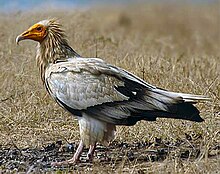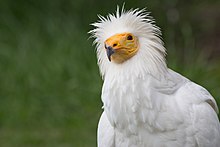白兀鹫
| 白兀鹫 | |
|---|---|

| |
| 成年的 N. p. ginginianus 亚种 | |
| 科学分类 | |
| 界: | 动物界 Animalia |
| 门: | 脊索动物门 Chordata |
| 纲: | 鸟纲 Aves |
| 目: | 鹰形目 Accipitriformes |
| 科: | 鹰科 Accipitridae |
| 属: | 白兀鹫属 Neophron Savigny, 1809 |
| 种: | 白兀鹫 N. percnopterus
|
| 二名法 | |
| Neophron percnopterus (Linnaeus, 1758)
| |

| |
| 白兀鹫的分布地 | |
白兀鹫(学名:Neophron percnopterus),又名埃及秃鹫,是一种稀少的秃鹫。它们分布在欧洲西南部及非洲北部至南亚。它们的翼底呈黑白色,尾巴呈楔状。它们有时会用石头敲破鸟蛋,是少数懂得使用工具的鸟类之一。在温带繁殖的群落会向南迁徙过冬,而在热带的多是留鸟。它们的数量于20世纪有所下降,而在岛屿中的群落则特别濒危。
特征[编辑]

白兀鹫的羽毛是白色的,飞羽黑色。它们的身体有时有些泥色是与其习性有关。喙幼长,上颔端有钩。鼻孔很长。颈部羽毛很长,双翼很尖,当中以第三主羽最长。尾巴呈楔状。爪子直而且长,第三及第四趾有小蹼。指名亚种的喙是黑色的,而印度亚种N. p. ginginianus的则较为淡色或黄色,但这种变化仍需更多证据支持。[2]面部皮肤是黄色的。[3]雏鸟是黑色或深褐色的,有黑白色的斑。[3]成年的白兀鹫全长85厘米,翼展1.7米。它们重约2公斤,但N. p. majorensis则平均重2.4公斤。[4]
分类[编辑]
白兀鹫属只有白兀鹫一个物种。此属相信是最古老的秃鹫分支之一,现存的最近亲是胡兀鹫。[5][6]有些学者更建议将它们分类到新的胡兀鹫亚科之中。[7]现时广泛接受的有三个白兀鹫的亚种,但它们之间却有很多混种。[8]俾路支地区及喜玛拉雅山西北部的N. p. rubripersonatus并未获得确认。[2][9]
- N. p. percnopterus:指名亚种,其分布最广,包括南欧、北非、中东、中亚及印度次大陆。它们在温带地区繁殖,并会向南过冬。
- N. p. ginginianus:体型最细小的亚种,喙呈淡色。它们分布在印度次大陆的大部分地区。其名是衍生自印度南部的京吉(Gingee)。[10]
- N. p. majorensis:体型最大的亚种。它们分布在加那利群岛,群落数量最少及最受限制。于2002年才确立为一个亚种,它们的基因较为接近N. p. percnopterus,而疏于N. p. ginginianus。它们不是候鸟。其名字是衍生自富埃特文图拉岛的古代名字。[11][12]
白兀鹫属的属名是取自希腊神话的涅俄佛隆(Neophron)。涅俄佛隆是Timandra的儿子,而Timandra则是Aegypius的情妇。涅俄佛隆将Aegypius的母亲幻化成Timandra,欺骗他与其母同寝。他母亲醒来后欲夺走他的眼睛,但宙斯却将涅俄佛斯及Aegypius变成秃鹫。[13]种小名则是指其黑色的双翼。[14]
分布[编辑]
白兀鹫广泛分布在南欧、北非、西亚及南亚。它们主要栖息在干旱平原。它们有时也会流浪到斯里兰卡[3]、欧洲北部及南非。[15]欧洲群落会向南迁徙3500-5500公里到达非洲,有时单日的旅程长达500公里。在法国曾有一只白兀鹫出生第三天就已经向南迁徙。[16][17]意大利的群落会横跨马雷蒂莫(Marettimo)及潘泰莱里亚,经西西里岛到达突尼斯。[18]
行为及生态[编辑]

白兀鹫经常会随热流上升。它们吃多种食物,包括哺乳动物的粪便(尤其是人类[19])、昆虫、尸体、植物及细小的猎物。[20]研究显示它们吃哺乳动物的粪便可以帮助它们摄取类胡萝卜素色素,令其面部皮肤呈鲜黄及橙色。[21]它们一般较为寂静,但若受到骚扰则会发出高音的叫声。[2]
白兀鹫是群居的[22],鸟巢会不断再用。它们很多时都是单独或成对的行动。它们是一夫一妻制的,夫妻的关系可以维持多于一个繁殖季节。成年雄鹫在雌鹫生蛋前后很多时都会留在其身边。[23]它们会在峭壁、建筑物及树上筑巢。[2]N. p. ginginianus及N. p. majorensis也会在地上筑巢。[24][25][26]印度群落的繁殖季节是于2月至4月。双亲都会孵蛋,孵化期为42天。[3]3-5天后就会孵化第二只雏鹫,但时间越长,其生存率就越低。[27]在鸟巢紧迫的地方,雏鹫有时会走到其他鸟巢寻找食物。[28]西班牙群落的幼鹫会在90-110天大时换羽及离开鸟巢。[29]幼鹫离开鸟巢后会到远达500公里以外的地方。[30][31]到了4-5岁大时,它们就会拥有成鸟的羽毛。饲养的白兀鹫寿命可达37岁。[32]
成年白兀鹫并没有很多天敌,但很多时却死于电缆、污染及中毒。幼鹫会被金雕、雕鸮及赤狐掠食。从峭壁上掉下的白兀鹫也会被胡狼所捡走。[33]
指名亚种是懂得使用工具的。它们会用喙将大卵石掷向大蛋,将其敲碎。[34]不过在N. p. ginginianus中却看不见这种行为。[2]研究发现这种行为并非学习得来的,而是天生的。[35]保加利亚群落也有使用树枝来卷起羊毛,用以制作鸟巢。[36]
保育状况[编辑]


白兀鹫在大部分分布地中都正经历严重的衰落。在欧洲及中东大部分地区,其数量只有20年前的一半;在印度及非洲西南部,它们的数量也大幅减少。于1967年至1970年,在德里附近地区就估计只有12000-15000只白兀鹫,平均密度为每10平方公里约有5对。[37][38]引起衰落的原因不明,但却与使用非甾体抗炎药双氯芬酸钠有关。[39]在南欧,它们的衰落也与铅中毒、使用杀虫剂和触电有关。[4][40]西班牙的研究发现吸收抗生素会抑制它们的免疫系统,造成较易的感染。[41]
加那利群岛群落与欧洲及非洲的群落分隔了一段颇长时间,而且大幅下降。它们以往广布在戈梅拉岛、特内里费岛、大加那利岛、富埃特文图拉岛及兰萨罗特岛,但现已只限于富埃特文图拉岛、兰萨罗特岛和两个最东的岛屿。它们的数量于2000年估计约有130只,共25-30繁殖对。[4][42]这些岛屿群落特别容易受到感染。[43]在吃腐肉的时候,它们积聚了大量的铅,令其骨头矿物化。[44]现时有措施提供安全及没有污染的食物,不过缺点是会吸引其他掠食性动物,增加对雏鹫的危害。[45]
2012年4月2日在新疆喀什乌恰县发现了一只白兀鹫,这是该鸟在中国分布的新记录。[46]
参考[编辑]
- ^ BirdLife International. Neophron percnopterus. The IUCN Red List of Threatened Species 2009.
- ^ 2.0 2.1 2.2 2.3 2.4 Rasmussen PC & JC Anderton. Birds of South Asia: The Ripley Guide. Volume 2. Smithsonian Institution and Lynx Edicions. 2005: 89.
- ^ 3.0 3.1 3.2 3.3 Ali S & SD Ripley. Handbook of the birds of India and Pakistan. Volume 1 2. Oxford University Press. 1978: 310–4.
- ^ 4.0 4.1 4.2 Donazar, Jose A.; Cesar J. Palacios, Laura Gangoso, Olga Ceballos, Maria J. Gonzalez, Fernando Hiraldo. Conservation status and limiting factors in the endangered population of Egyptian vulture (Neophron percnopterus) in the Canary Islands (PDF). Biological Conservation. 2002, 107 (1): 89–97. doi:10.1016/S0006-3207(02)00049-6. (原始内容 (PDF)存档于2011-07-08).
- ^ Wink, M. Phylogeny of Old and New World Vultures (Aves: Accipitridae and Cathartidae) Inferred from Nucleotide Sequences of the Mitochondrial Cytochrome b Gene (PDF). Zeitschrift for Naturforschung C. 1995, 50 (11/12): 868–82 [2010-11-16]. (原始内容 (PDF)存档于2012-03-16).
- ^ Wink, Michael; Petra Heidrich, Claus Fentzloff. A mtDNA phylogeny of sea eagles (genus Haliaeetus) based on nucleotide sequences of the cytochrome b-gene. Biochemical Systematics and Ecology. 1996, 24 (7-8): 783–91. doi:10.1016/S0305-1978(96)00049-X.
- ^ Seibold, Ingrid; Helbig, Andreas J. Evolutionary History of New and Old World Vultures Inferred from Nucleotide Sequences of the Mitochondrial Cytochrome b Gene. Phil. Trans. R. Soc. Lond. B. 1995, 350 (1332): 163–78. PMID 8577858. doi:10.1098/rstb.1995.0150.
- ^ Donázar, José Antonio; Negro, Juan José; Palacios, César Javier; Gangoso, Laura; Godoy, José Antonio; Ceballos, Olga; Hiraldo, Fernando; & Capote, Nieves. Description of a new subspecies of the Egyptian Vulture (Accipitridae: Neophron percnopterus) from the Canary Islands (PDF). Journal of Raptor Research. 2002, 36 (1): 17–23. (原始内容 (PDF)存档于2011-07-08).
- ^ Hartert, Ernst. Die Vögel der paläarktischen Fauna. Volume 2. Friendlander & Sohn, Berlin. 1910: 1200–2.
- ^ Pittie A. A dictionary of scientific bird names originating from the Indian region (PDF). Buceros. 2004, 9 (2). (原始内容 (PDF)存档于2010-04-01).
- ^ Kretzmann MB; N. Capote; B. Gautschi; J.A. Godoy; J.A. Donázar & J.J. Negro. Genetically distinct island populations of the Egyptian vulture (Neophron percnopterus) (PDF). Conservation Genetics. 2003, 4 (6): 697–706. doi:10.1023/B:COGE.0000006123.67128.86. (原始内容 (PDF)存档于2011-07-20).
- ^ Donázar, José Antonio; Negro, Juan José; Palacios, César Javier; Gangoso, Laura; Godoy, José Antonio; Ceballos, Olga; Hiraldo, Fernando; & Capote, Nieves. Description of a new subspecies of the Egyptian Vulture (Accipitridae: Neophron percnopterus) from the Canary Islands (PDF). Journal of Raptor Research. 2002, 36 (1): 17–23. (原始内容 (PDF)存档于2011-07-08).
- ^ Grimal, Pierre. The dictionary of classical mythology. Wiley-Blackwell. 1996: 18. ISBN 0631201025.
- ^ Koenig, Alexander, Alexander. Die Geier Aegyptens. Journal of Ornithology. 1907, 55 (1): 59–134. doi:10.1007/BF02098853 (德语).
- ^ Mundy PJ. The Egyptian vulture (Neophron Percnopterus) in Southern Africa. Biological Conservation. 1978, 14 (4): 307–15. doi:10.1016/0006-3207(78)90047-2.
- ^ Meyburg, Bernd-U.; Gallardo, Max; Meyburg, Christiane; Dimitrova, Elena. Migrations and sojourn in Africa of Egyptian vultures ( Neophron percnopterus) tracked by satellite. Journal of Ornithology. 2004, 145 (4): 273–80. doi:10.1007/s10336-004-0037-6.
- ^ García-Ripollés, Clara; Pascual López-López; Vicente Urios. First description of migration and wintering of adult Egyptian Vultures Neophron percnopterus tracked by GPS satellite telemetry. Bird Study. 2010, 57 (2): 261–5. doi:10.1080/00063650903505762.
- ^ Agostini N., Premuda G., Mellone U., Panuccio M., Logozzo D., Bassi E.,Cocchi L. Crossing the sea en route to Africa: autumn migration of some Accipitriformes over two Central Mediterranean islands (PDF). Ring. 2004, 26 (2): 71–8 [2010-11-16]. doi:10.2478/v10050-008-0062-6. (原始内容 (PDF)存档于2012-03-26).
- ^ Whistler, Hugh. Popular Handbook of Indian Birds 4. Gurney & Jackson. 1949: 356–7. ISBN 1406745766.
- ^ Prakash, Vibhu; Nanjappa, C. An instance of active predation by Scavenger Vulture (Neophron p. ginginianus) on Checkered Keelback watersnake (Xenochrophis piscator) in Keoladeo National Park, Bharatpur, Rajasthan. J. Bombay Nat. Hist. Soc. 1988, 85 (2): 419.
- ^ Negro, J. J. Negro, J. M. Grande, J. L. Tella, J. Garrido†, D. Hornero†, J. A. Donázar, J. A. Sanchez-Zapata‡, J. R. Benítez, M. Barcell. An unusual source of essential carotenoids (PDF). Nature. 2002, 47: 807 [2010-11-16]. (原始内容 (PDF)存档于2014-03-20).
- ^ Donázar JA, Ceballos O, Tella JL. Communal roosts of Egyptian vultures (Neophron percnopterus): dynamics and implications for the species conservation. Muntaner J, Mayol J (编). Biology and Conservation of Mediterranean Raptors (PDF). Monografía SEO-BirdLife, Madrid. 1996: 189–201. (原始内容 (PDF)存档于2011-07-20).
- ^ Donázar, J. A. , Ceballos, O. and Tella, J. L. Copulation behaviour in the Egyptian Vulture Neophron percnopterus. Bird Study. 1994, 41 (1): 37–41. doi:10.1080/00063659409477195.
- ^ Biddulph,CH. Unusual site for the nest of the White Scavenger Vulture Neophron percnopterus ginginianus (Lath.). J. Bombay Nat. Hist. Soc. 1937, 39 (3): 635–6.
- ^ Paynter, WP. Lesser White Scavenger Vulture N. ginginianus nesting on the ground. J. Bombay Nat. Hist. Soc. 1924, 30 (1): 224–225.
- ^ Gangoso, Laura. Ground nesting by Egyptian Vultures (Neophron percnopterus) in the Canary Islands (PDF). Journal of Raptor Research. 2005, 39 (2): 186–7 [2010-11-16]. (原始内容存档 (PDF)于2020-09-24).
- ^ Donazar JA & O Ceballos. Growth rates of nestling Egyptian Vultures Neophron percnopterus in relation to brood size, hatching order and environmental factors (PDF). Ardea. 1989, 77 (2): 217–26. (原始内容 (PDF)存档于2011-07-20).
- ^ Donazar, J. A. & Ceballos O. Acquisition of food by fledgling Egyptian Vultures Neophron percnopterus by nest-switching and acceptance by foster adults. Ibis. 1990, 132 (4): 603. doi:10.1111/j.1474-919X.1990.tb00284.x.
- ^ Donazar JA & O Ceballos. Post-fledging dependence period and development of flight and foraging behaviour in the Egyptian Vulture Neophron percnopterus (PDF). Ardea. 1989, 78: 387–94. (原始内容 (PDF)存档于2011-07-20).
- ^ Elorriagaa J; Iñigo Zuberogoitiab, Iñaki Castilloc, Ainara Azkonac, Sonia Hidalgoc, Lander Astorkiac, Fernando Ruiz-Moneoc, and Agurtzane Iraetac. First Documented Case of Long-Distance Dispersal in the Egyptian Vulture (Neophron percnopterus) (PDF). Journal of Raptor Research. 2009, 43 (2): 142–5. doi:10.3356/JRR-08-53.1. (原始内容 (PDF)存档于2010-04-01).
- ^ Ceballos, O & J A Donazar. Roost-tree characterstics, food habits and seasonal abundance of roosting Egyptian Vultures in northern Spain (PDF). J. Raptor. Res. 1990, 24 (1-2): 19–25 [2010-11-16]. (原始内容 (PDF)存档于2010-08-09).
- ^ Juan M. Grande, David Serrano, Giacomo Tavecchia, Martina Carrete, Olga Ceballos, Ricardo Dıaz-Delgado, Jose L. Tella and Jose A. Donazar. Survival in a long-lived territorial migrant: effects of life-history traits and ecological conditions in wintering and breeding areas (PDF). Oikos. 2009, 118: 580–90. doi:10.1111/j.1600-0706.2009.17218.x. (原始内容 (PDF)存档于2011-07-20).
- ^ Stoyanova, Y. and N. Stefanov. Predation upon nestling Egyptian Vultures (Neophron percnopterus) in the Vratsa Mountains of Bulgaria (PDF). J. Raptor Res. 1993, 27 (2): 123 [2010-11-16]. (原始内容 (PDF)存档于2010-08-09).
- ^ van Lawick-Goodall, Jane; Hugo van Lawick. Use of Tools by the Egyptian Vulture, Neophron percnopterus. Nature. 1966-12-24, 212 (5069): 1468–9. doi:10.1038/2121468a0.
- ^ Thouless CR, Fanshawe JH, Bertram BCR. Egyptian Vultures Neophron percnopterus and Ostrich Struthio camelus eggs: the origins of stone-throwing behaviour. Ibis. 1989, 131 (1): 9–15. doi:10.1111/j.1474-919X.1989.tb02737.x.
- ^ Stoyanova, Yva; Nikolai Stefanova and Josef K Schmutz. Twig Used as a Tool by the Egyptian Vulture (Neophron percnopterus). Journal of Raptor Research. 2010, 44 (2): 154–6. doi:10.3356/JRR-09-20.1.
- ^ Galushin VM. Populations of vultures and other raptors in Delhi and neighboring areas from 1970's TO 1990's. Parry-Jones J & T Katzner (编). Report from the Workshop on Indian Gyps vultures: 4th Eurasian congress on raptors, Sevilla, Spain (PDF). 2001: 13–5. (原始内容 (PDF)存档于2011-07-16).
- ^ Galushin VM. A comparative analysis of the density of predatory birds in two selected areas within the Palaearctic and Oriental regions, near Moscow and Delhi (IOC Abstracts). Emu. 1975, 74: 331.
- ^ Cuthbert R, Green R.E, Ranade S, Saravanan S.S, Pain D.J, Prakash V, Cunningham A.A. Rapid population declines of Egyptian vulture Neophron percnopterus and red-headed vulture Sarcogyps calvus in India. Anim. Conserv. 2006, 9: 349–54. doi:10.1111/j.1469-1795.2006.00041.x.
- ^ Hernández, Mauro & Antoni Margalida. Poison-related mortality effects in the endangered Egyptian vulture (Neophron percnopterus) population in Spain (PDF). European Journal of Wildlife Research. 2009, 55 (4): 415–23 [2010-11-16]. doi:10.1007/s10344-009-0255-6. (原始内容 (PDF)存档于2014-03-20).
- ^ Lemus, Jesús A. and Guillermo Blanco. Cellular and humoral immunodepression in vultures feeding upon medicated livestock carrion. Proc. Biol. Sci. 2009, 276 (1665): 2307–13. PMC 2677603
 . PMID 19324751. doi:10.1098/rspb.2009.0071.
. PMID 19324751. doi:10.1098/rspb.2009.0071.
- ^ Palacios, Cesar-Javier; Schaefer, H. Martin; Schmidt, Veronika; SchrÖder, Boris. Current status and distribution of birds of prey in the Canary Islands (PDF). Bird Conservation International. 2004, 14: 203–13 [2010-11-16]. doi:10.1017/S0959270904000103. (原始内容 (PDF)存档于2016-03-03).
- ^ Gangoso L, Grande JM, Lemus JA, Blanco G, Grande J & José A. Donázar. Susceptibility to Infection and Immune Response in Insular and Continental Populations of Egyptian Vulture: Implications for Conservation. PLoS ONE. 2009, 4 (7): e6333. PMC 2709727
 . PMID 19623256. doi:10.1371/journal.pone.0006333.
. PMID 19623256. doi:10.1371/journal.pone.0006333.
- ^ Gangoso L; Pedro Alvarez-Lloret; Alejandro. A.B. Rodriguez-Navarro; Rafael Mateo; Fernando Hiraldo and Jose Antonio Donazar. Long-term effects of lead poisoning on bone mineralization in vultures exposed to ammunition source. Environmental Pollution. 2009, 157 (2): 569–74. PMID 18995938. doi:10.1016/j.envpol.2008.09.015.
- ^ Cortés-Avizanda, A., Carrete, M., Serrano, D. and Donázar, J. A. Carcasses increase the probability of predation of ground-nesting birds: a caveat regarding the conservation value of vulture restaurants. Animal Conservation. 2009, 12: 85–8. doi:10.1111/j.1469-1795.2008.00231.x.
- ^ 新疆鸟友今年发现三个鸟类新记录 六种罕见鸟种. 新浪新疆. [2021-09-28]. (原始内容存档于2021-09-28).
外部链接[编辑]
| 维基共享资源中相关的多媒体资源:白兀鹫 |
|

